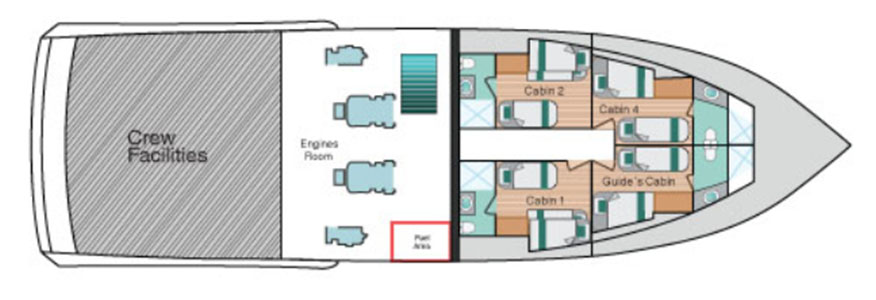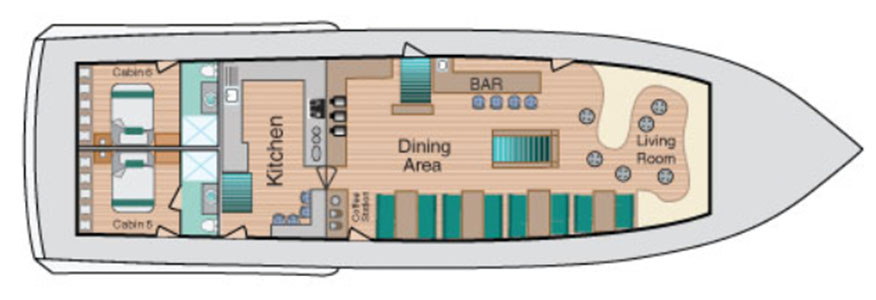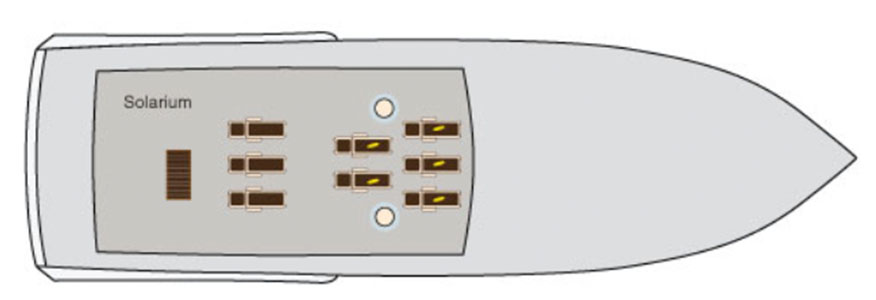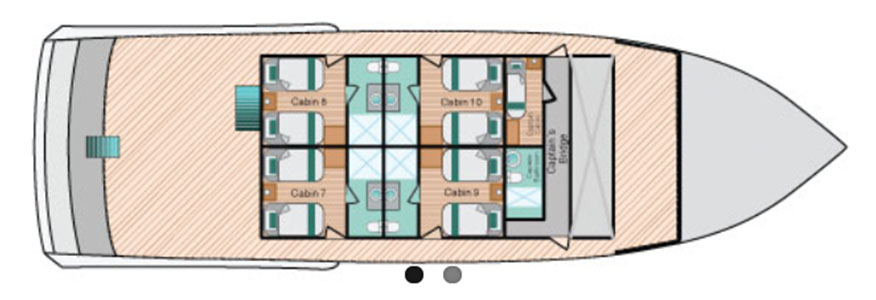M/Y Bonita
Capacity
16 passengers
Motor
2 Caterpillar 8 cylinder motors
Beam
6 mts / 22 ft
Length
25 mts / 83 ft
Performance
Cruising speed: 9 knotsWater capacity: 2500 gallons
M/Y Bonita
Description
Family cruise recently completely renovated in January 2020, this cruise is intended for those who want to live a trouble-free travel experience at an attractive price.
Included
- Accommodations
- All meals
- Soft drinks
- Island sightseeing
- Naturalist guides and lecture services in English/Spanish only
- Wet suit rental, snorkeling gear
- Taxes and transfers in the islands
Excluded
- Air transportation to / from Galápagos and airport taxes (subject to change without previous notice).
- Galápagos National Park entrance fee (US$ 100 subject to change without previous notice).
- INGALA migration Control Card (US $ 20 subject to change without previous notice).
- Alcoholic beverages, gratuities, gifts and additional items.
Starting
$0.00
/ person
Book This Tour
Itineraries
SUNDAY: BALTRA AIRPORT – CERRO DRAGON (DRAGON HILL)
CERRO DRAGON: After lunch our first visit is to Dragon Hill which is located in the northwestern area of Santa Cruz Island. It consists of a 1,600 m long trail running through 3 different environments. In 1975, it was one of the only places on Santa Cruz Island where healthy land iguanas (Conolophus Subcristatus) could be found. That same year, the Galapagos National Park and the Charles Darwin Foundation initiated a program to conserve land iguanas. In the lagoons found here, there are shrimp (Artemia salina), the food of the flamingos. At certain times of the year, the shrimp are more abundant and the flamingo population increases. Dinner.
-/L/D
MONDAY: BUCANERO – PLAYA ESPUMILLA – PUERTO EGAS
ESPUMILLA BEACH & BUCCANEER COVE: The main attractions include Palo Santo Wood, the beach, and the stunning landscape; the beach is a very important site for tortoises because they use this place for nesting. Once time, the pigs were the main predatory of tortoise’s eggs; pigs were eradicated with the creation of Isabela Project. Lunch
EGAS PORT: Here we find a beautiful black sand beach; to the south of the beach is the Pan de Azucar Volcano, whose volcanic deposits have contributed to the formation of the black sand beach. The crater of this volcano contains a saltwater lake that dries up during hot weather. Between 1928 and 1930, explorations to develop a salt mine were carried out, but it was decided that a mine was not feasible. The workers’ use of endemic woods also damaged the environment and the development was scrapped. Descent to the salt mine is not allowed. Dinner.
B/L/D
TUESDAY: ISABELA – FERNANDINA
ISABELA ISLAND: VICENTE ROCA POINT is comprised of two separate coves, this site is a large bay with spectacular sea life. Keep an eye out for seahorses, sea turtles, and the strange yet fascinating Mola-mola (sunfish). Lunch.
FERNANDINA ISLAND – ESPINOZA POINT: Fernandina is the third biggest island in the Galapagos and has only one visiting site: Espinoza Point, famous for the large colonies of marine iguanas and the home of the flightless cormorant, the Galapagos penguin, snakes, and more. From Espinoza Point, we can admire the beauty of Fernandina Island and its volcano which last erupted in May of 2005. Fernandina is the only island that doesn’t have mammals and the open areas are extremely fragile. From January to June, the nesting period of the marine iguana, we take great care when walking. Dinner.
B/L/D
WEDNESDAY: ISABELA
ISABELA ISLAND – URBINA BAY: this place is located at the base of Alcedo Volcano between Elizabeth Bay and Tagus Cove. Wet landing. Trail length is around 3.20 Km; during this walk, we can observe land iguanas, hawks, and tortoises. It is also possible to see red and blue lobsters. Lunch.
ISABELA ISLAND – TAGUS COVE: It is located to the west of Darwin Volcano on Isabela Island. While walking, we will find several inscriptions (names of pirates) dating back to the 1800’s. From here, we can see Darwin Lake, a salt water lake with a depth of approximately 9 m. It contains no fish. It is very common to see a variety of bird species. Dinner.
B/L/D
THURSDAY: ISABELA
ISABELA ISLAND – MORENO POINT. We will disembark at Moreno Point which is located near Elizabeth Bay on the west coast of Isabela Island. The plethora of birds seen during a dinghy ride along the striking rocky shores or a hike along a path through lava rock leading to tide pools and mangroves, create a birdwatcher’s delight. In the tide pools, green sea turtles or white-tip sharks can be spotted. Lunch.
ISABELA ISLAND – ELIZABETH BAY: After lunch, this is one of the island’s breeding sites for penguins. Located on the west coast of Isabela, Elizabeth Point is a marine visitor site. Visit Red Mangrove Cove: Brown pelicans, flightless cormorants, spotted eagle rays, golden rays and sea lions are often seen. Dinner.
B/L/D
FRIDAY: ISABELA
ISABELA ISLAND – TINTORERAS: Located in the bay of Puerto Villamil, this small island, surrounded by calm, turquoise waters have an easy trail with great landscapes and very interesting fauna. Along the trail we will see large numbers of Marine Iguanas basking in the sun, lava lizards, herons, gulls and sea lions. In the coves, it is easy to find Sea Turtles, rays and even penguins. Among the many inlets and channels on the coast, we sometimes see White-tipped Reef Sharks (in Spanish “Tintoreras”). Following the excursion, we will return to the boat for breakfast and sail to our next destination. Lunch.
ISABELA ISLAND – HUMEDALES: Los Humedales is one of the Isabela Hidden Gems. “Humedales” translates to Wet Lands and this area is characterized by sandy beaches, rocky shores, and mangroves, which have an extremely important role in the Galapagos as they provide a nursery for young marine animals as well as a nesting site for birds. Following the various paths, you will find a fabulous destination for bird lovers, pink flamingos and migratory birds including black-bellied and semipalmated plovers, whimbrel, osprey, greater and lesser yellowlegs, wilson’s phalarope, short-billed dowitcher, common tern, blue-winged teal, to name a few. You can also observe young giant tortoises from the Isabela Breeding Center. Dinner
B/L/D
SATURDAY: CHARLES DARWIN – AIRPORT
SANTA CRUZ ISLAND – CHARLES DARWIN
After breakfast, we will visit Charles Darwin Station which is located in the main port on Santa Cruz Island; we will take a private bus to the entrance of the breeding center where we will see tortoises and land iguanas in captivity. This center is the main breeding site on the islands. Animals that were in danger of extinction on the various islands are maintained in captivity. Thanks to the dedicated work of several institutions, some species are being saved. Here lived Lonesome George, the famous last survivor of the giant tortoise species found on Pinta Island. Transfer to the airport.
B/-/-
B = Breakfast L = Lunch D = Dinner
SATURDAY: SANTA CRUZ HIGHLANDS
SANTA CRUZ HIGHLANDS: After your arrival and lunch on board, we will visit the interesting HIGHLANDS OF SANTA CRUZ, where we will hike and encounter giant tortoises in their natural habitat, a natural wonder. For this visit we recommend to use sport shoes, long pants, raincoat, hat and sun block. Dinner.
-/L/D
SUNDAY: FLOREANA
FLOREANA – CORMORANT POINT: Wet landing, snorkeling and short trekking. This point is located at west of Floreana Island and it is famous for its dark green beach (due to the great quantity of olivine crystals). You can see many marine invertebrates, as well as sea lions, sea iguanas, the frigates and pelicans.
DEVIL´S CROWN: Activities in this place: panga ride and optional swimming. Enjoy a panga ride around a small island, a satellite islet of Floreana Island. Here, we will find a group of rocks that resemble a Crown due to the constant erosion caused by the sea. It is one of the better places to snorkel (shallow diving) in the interior and around the crown. Excellent visibility allows guests to admire a great variety of fish and sea animals. Lunch
FLOREANA – POST OFFICE: (Mail Bay): Wet landing. Activities: short walk, swimming, snorkeling, explanation of the mail system. Description: Mail Bay is located on the north side of Floreana Island. Captain James Colnett installed an empty barrel to be used as a post office for the whaling fleets that stopped at the Galapagos Islands. You can leave postcards to your friends and relatives here and/or pick up mail to deliver. Back at the ship, Delicious snacks and beverages are waiting for you. Dinner.
B/L/D
MONDAY: ESPAÑOLA
SUAREZ POINT: Dry landing. Activities: Walking, sight-seeing. We recommend sports shoes, hat or cap, and sunscreen. There is no color more amazing and outstanding in this tropical desert island, than that of the blue-foot boobies. These birds have an impressive form of “greeting” and it is a real thrill to see their mating dance. The blue-footed booby can be seen on several of the islands as nesting grounds and feed are located in several coastal locations. The albatross, an aristocratic bird weighing up to four kilograms, can be observed here. One of the largest birds of the islands, approximately 12,000 couples nest on Espanola Island and a smaller number nest on Silver Island, near mainland Ecuador. This species is considered endemic to this island; during our walk, we will observe these fantastic birds while taking in the beautiful landscapes offered by this island. It is important to note that albatrosses will not be seen between January and March (non-breeding) season. We will also see colonies of marine iguanas, zayapas, masked boobies, finches, Espanola cucuves, and seagulls unique to the islands. Our walk will be on lava rock where we will be able to see lava tubes. Red mangroves are found here. Delicious snacks and fresh beverages are waiting for you on the ship. Lunch
GARDNER BAY: wet landing, activities for this visit: short walk, swimming, snorkeling, and observation of seal colony. The sea lion is one of the animals in Galapagos which gets the total attention of the visitors in the Galapagos: they are curious and playful, but at times aggressive; they are nice and loving, but also lazy. In Gardner Bay, we are going to find many of them relaxing on the beach enjoying the sun. In addition to observing these fascinating animals, while snorkeling, we will be able to swim with sea lions, sea turtles, a diversity of tropical fish, marine iguanas, etc. Dinner.
B/L/D
TUESDAY: SAN CRISTOBAL / KICKER ROCK
SAN CRISTOBAL – INTERPRETATION CENTER: Dry landing. This center is location in the main port. After breakfast, our first visit is to the Interpretation Center of San Cristobal. This modern and sophisticated architectural space was designed for the natural interpretation of the Galapagos. You will learn about the volcanic formation of the islands, the evolution of the species, the history of human settlement, and complex systems and management models. Lunch
Kicker Rock: This is one of the most incredible rock formations at the Galapagos Islands, also known as Sleeping Lion; close to San Cristobal. (30 minutes of navigation appr.). You will find an immense number of birds (Frigates, Blue Footed Boobies and Nazca Boobies, sea shore birds, etc). Snorkeling will be one of the most important activities here, where to observe: manta rays, sea lions, sea turtles, sharks (like Hammerheads, Galapagos Shark, With-tip Reef sharks), among others.
LOBOS ISLANDS: Panga Riding, swimming and snorkeling. Here, we can walk, swim and snorkel among the seals, frigates, marine iguanas, lava lizards, and the small endemic Galapagos snake. Here, we can swim and snorkeling in the same place it. Dinner.
B/L/D
WEDNESDAY: BACHAS – TRANSFER OUT
BACHAS: This beautiful sandy white-coral beach is located in the north of Santa Cruz Island; the beach is one km long. The site was named during WWII (World War II) when the American army left two barges on the beach. The early colonists couldn’t pronounce barges correctly, so they called the area “Bachas”. It is considered as one of the nesting sites for sea turtles. We can also observe, flamingos, seabirds and white-cheeked pintail ducks. Transfer to the airport
B/L/D
B = Breakfast L = Lunch D = Dinner
WEDNESDAY: PLAZAS
SOUTH PLAZAS: After your arrival and lunch on board, we will visit Plazas, two small islands, created by an uplifting of the land. The land iguanas are smaller here; they nest during the warm season. The hike goes along an extraordinary cliff where sea birds nest. There are approximately 1000 sea lions (Zalophus Wollebaeki) located on the south side of the Plazas. Dinner.
-/L/D
THURSDAY: BLACK TURTLE COVE – SANTA CRUZ HIGHLANDS
BLACK TURTLE COVE: Our first visit is to Black Turtle Cove which is situated in the northern region of Santa Cruz. This bay is surrounded by mangroves and is accessible only by dinghy only. The shallow cove is a safe refuge for marine life. Black-tip reef sharks, marine turtles, and a variety of rays are often spotted here. Lunch
SANTA CRUZ HIGHLANDS: Here we have a trekking and we will find the giant tortoises in their natural habitat, this is a natural spectacle. For this visit, we recommend good walking shoes, long pants, a raincoat, a hat, and sunblock. Dinner.
B/L/D
FRIDAY: GENOVESA ISLAND: DARWIN BAY & BARRANCO
DARWIN BAY: wet landing, coral beach, activities for this day: short walks, photography, swimming, snorkeling. Genovesa is a small island in the north of the Galapagos. Our unloading in Darwin Bay will be wet. Near the beach is a mangrove swamp where we will find a colony of frigates, marine iguanas, red-footed boobies and mask boobies, the great terrestrial finch, seagulls, herons, and cactus finch. Following the land visit, our passengers can enjoy a swim in the bay. Snacks and refreshments are available. Lunch.
BARRANCO: dry landing, activities: hiking. Also known as Prince Phillip’s stairs. Here, we will go for a walk on the Barranco path. On our journey we will observe tropical birds, petrels, common frigate, red-foot boobies, mask boobies, doves, and finches. Dinner.
B/L/D
SATURDAY: SANTIAGO ISLAND: SULLIVAN BAY & BARTOLOME ISLAND
SANTIAGO ISLAND: SULLIVAN BAY: wet landing and hiking. Description: Virtually uneroded lava flows cover an extensive area of this island. Lava pahoehoe (basaltic lava that has a smooth, billowy, undulating or ropy surface), hornitos, and mollugo (a lava colonizer) can be seen. Snacks and refreshing beverages await you on board the ship. Lunch.
BARTOLOME ISLAND: dry landing, wet landing for the beach. Activities on this island include: walking, swimming, snorkeling, and photography. We will follow a path to the top (114m) where we can see pioneering plants such as tiquilia, chamaesyce, and scalesia. The island has been formed by cones, lava pipes where lava once flowed. Following the wet landing at the beach, we will follow a path through mangrove swamps and sand dune vegetation, to the south beach. At the north beach, guests can enjoy swimming and snorkeling. From the top of Bartolome, we will be able to see the islands of Santiago, Rabida, and Isabela. We will see penguins in the Rock Pinnacle. Dinner.
B/L/D
SATURDAY: SEYMOUR – TRANSFER OUT
SEYMOUR: dry landing. Seymour was formed by the lifting of volcanic marine lava. Marine fossils dating back to the Pleistocene period were found on this island. In 1932, Captain Alan Hancock and his crew took 72 malnourished land iguanas from Baltra Island to North Seymour Island so that the iguanas could live in better conditions. In 1934, colonists verified that the iguanas were in good condition. The vegetation of North Seymour is bushy and is host to nesting Real Frigates of the Galapagos. Transfer to the airport.
B/-/-
B = Breakfast L = Lunch D = Dinner
Deck Plans
Gallery
Company
Contact Us:
- Address: Checoslovaquia E9-95 St., Eveliza Plaza building. Quito-Ecuador
- jorge@exclusiveecuador.info
- TOLL FREE USA & CAN 1-866-454-9060
- TELEPHONE UK +44-2033-724723
- TELEPHONE ECUADOR +593-2-333-3718
- MOBILE ECUADOR +593-99-281-3776





